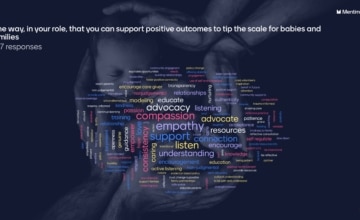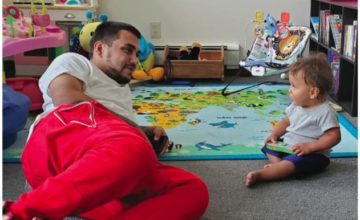Definition: Establishing shared understanding and joint leadership to make greater progress toward common goals. The purpose is to develop a system that addresses the needs of young children and their families in a broad-based and coordinated way.
STRATEGIES
- Use common advisory bodies for multiple programs (home visiting, Early Childhood Comprehensive Services [ECCS], Project LAUNCH [Linking Unmet Needs for Children’s Health], etc.) or have liaisons between the groups
- Develop a formal relationship between home visiting and state-level coordinating and governance structures such as the Early Childhood Advisory Council
- Ensure home visiting is represented on local early childhood coalitions
- Conceptualize projects that cross systems and develop proposals for carrying them out
- Engage in joint strategic planning for system-building
Wisconsin
Wisconsin’s Early Childhood Advisory Council made three key recommendations to the governor in 2016, including doubling the number of families served by home visiting.
- The other two recommendations to the governor (based on 5 years of work) were doubling the number of children served in child care and expanding public-private partnerships.
Arizona
Arizona created an Interagency Leadership Team and Strong Families Home Visiting Alliance as coordinating structures.
- The Interagency Leadership Team is composed of representatives from the Arizona Department of Economic Security, Arizona Department of Education, Arizona Department of Health Services including the Bureau of Women and Children’s Health/Title V, the Arizona Health Care Cost Containment program (Medicaid) including the Division of Behavioral Health Services, Arizona Early Intervention Program (Part C), and First Things First, as well as consultants and evaluators for the Maternal, Infant, and Early Childhood Home Visiting (MIECHV) program. The purpose is to provide input on strategic and operational issues related to the MIECHV grant, promote the development and enhancement of home visiting in Arizona, and coordinate and leverage home visiting resources
- The Strong Families Home Visiting Alliance includes 82 members from 45 organizations interested in home visiting for young children and their families. Its purpose is networking and resource sharing related to early childhood home visiting and providing input and feedback on issues related to the development and enhancement of home visiting in Arizona. It oversees the following work groups: Coordinated Data Management System (goal is to determine feasibility of a coordinated data management system for MIECHV partners and potentially Strong Families Home Visiting Alliance partners); Coordinated Referral Systems (goal is to identify, develop, and enhance local home visiting referral systems and communication among them); and Professional Development (goal is to support development of a professional development system for home visitors).
Washington
Washington developed a formal private-public governance structure for home visiting, which includes an advisory committee, partnership group, and leadership forum.
- The Advisory Committee is required in the Home Visiting Services Account state statute to advise the Department of Early Learning and Thrive Washington on service delivery, evaluation, and quality implementation. The advisory committee includes state systems partners, local leaders, professional development providers, and other key partners. This group meets monthly.
- The Partnership Group includes mid-level state systems leaders who meet quarterly to discuss implementation, strategy, and systems coordination and integration.
- The Home Visiting Leadership Forum is comprised of state agency executives and private funders who meet two to three times per year to provide strategic guidance to the Home Visiting Executive Leadership and Home Visiting Management Team.
Choctaw Nation of Oklahoma
Choctaw Nation of Oklahoma signed a Memorandum of Understanding (MOU) to create a system of care.
- The programs have formalized their Tribal Early Learning Initiative (TELI) partnership and celebrated the “Day of the Young Child” on April 17, 2015, with the signing of a MOU.
- The goal outlined in the MOU is to provide more opportunities for a system of care across early childhood programs, including: (1) a standard release of information form, (2) a joint application form, (3) shared professional development opportunities, and (4) a strengthened referral system.
Port Gamble/S’Klallam
Port Gamble/S’Klallam is using the Touchpoints approach as the basis for creating a system of care across the range of partners working to support families.
- The tribe is creating a cohesive and consistent understanding of the Touchpoints approach across the range of partners (Head Start, Early Head Start, MIECHV, health and mental health providers, social services, child welfare, etc.) working to support families in navigating children’s social and emotional development.
- Touchpoints is an approach that helps parents understand the disorganization and regressions that may accompany their children’s developmental shifts and also enhances the capacity of providers and professionals working with families to connect with families when their involvement is most likely to be appreciated and their messages most likely to be helpful. Touchpoints provides a common language of child behavior and development that enables families and providers to work together and professionals to collaborate.
Great Plains
Great Plains Tribal Chairman’s Health Board of South Dakota created the 1,000 Days Initiative Interagency Forum to create a trauma-informed system of care.
- The tribe created the First 1,000 Days Initiative Interagency Forum to bring partners together from tribal health, Indian Health Service, social services, MIECHV, ECCS, Healthy Start, Head Start, and others to create a trauma-informed system of care for the children and families they serve.
- This work was driven by the ECCS strategic plan.
Cherokee Nation
Cherokee Nation created the HERO (Helping Everyone Reach Out) Project as a result of a Substance Abuse and Mental Health Services Administration (SAMHSA) Systems of Care for Early Childhood Planning/Expansion grant to focus on creating a system of care.
- The HERO Project is a strategy to join service providers and various programs (partners across LAUNCH, MIECHV, Head Start and Early Head Start, school districts, health care, and child care) into a seamless continuum of services and interventions aimed at improving overall outcomes for children—with mental health as the central focus.
Pascua Yaqui
The Pascua Yaqui Tribal Council established a Tribal Child and Family Providers Networking Board to work across tribal departments, agencies, and offices to coordinate development of policy recommendations and improve the quality of life for all tribal members.
Missouri
Missouri’s Coordinating Board for Early Childhood has a work group focused on home visiting that is working to improve the state home visiting system. The state has also worked with communities to develop Early Childhood Comprehensive System teams and to integrate home visiting in those teams at the local level.
- Missouri’s Governor-appointed Coordinating Board for Early Childhood acts as the State Advisory Council.
- The membership of this group includes the state agencies that have home visiting funding, along with some of the models implemented in Missouri and the Head Start State Collaboration Office.
Colorado
Home visitors and their supervisors are involved in the Colorado Early Childhood Councils that complement state-level systems work.
- Colorado has 31 Early Childhood Councils that are statutorily responsible for increasing and sustaining the quality, accessibility, capacity, and affordability of early childhood services for children 5 years old or younger and their parents.
Montana
Montana’s Best Beginnings Coalitions are local early childhood networks that include home visiting representatives and complement state-level systems work.
- Montana has a state-level Best Beginnings Advisory Council and 25 local coalitions.
Red Cliff Band of Lake Superior Chippewa Indians
Red Cliff Band of Lake Superior Chippewa Indians’ health and early childhood programs decided on a common vision for families in their tribe and are strategic in looking for funding to move their work forward.
- In addition to funding for programs, collaborative work has been done through Project LAUNCH, Healthy Start, and TELI grants.
- Partnerships between community health, primary care, and early learning have intentionally been deepened since 2006.
Rhode Island
Rhode Island built on their ECCS plan to develop a cross-agency blended funding model to support home visiting.
- The 2005 Successful Start ECCS plan identified the need for sustainable, blended funding and enhanced evidence-based home visiting services.
- Kids Count was the intermediary to bring state agencies together.
- Implementation of the plan resulted in blended funding (MIECHV, Part C, Community-Based Child Abuse Prevention, Temporary Assistance for Needy Families, Medicaid) for expansion of home visiting services and referral, coordination, and CQI systems for home visiting.
Intertribal Council of Michigan
Intertribal Council of Michigan brought together representatives of 12 tribes to create a vision and plan around health, community safety, and education for children birth to 8 years old and their families.
- The Honoring Our Children project, funded by the W.K. Kellogg Foundation, started in 2012 and provided flexible funding to conduct this collaborative work.
- TELI is also providing resources to support coordination of early childhood programs.
- The 12 federally recognized tribes and one urban Indian center in Michigan are involved.
Illinois
In Illinois, the home visiting task force is a standing committee of the Early Learning Council, and pilot programs have linked home visiting with homelessness, child welfare, and mental health.
- Home visiting is also discussed at regular state interagency meetings, which include funders of home visiting (home visiting is funded by the Illinois Department of Education, Illinois Department of Health and Human Services, and through the state’s federal MIECHV grant).
West Virginia
West Virginia’s cross-system initiatives have included home visiting in establishing an Infant Mental Health Association and endorsement process, formalizing a referral process with Part C, and developing linkages between home visitors and homeless shelters.
- The Early Childhood Advisory Council took on infant mental health and is using various funding streams to purchase Michigan’s Competency Guidelines and Endorsement for Culturally Sensitive, Relationship-Focused Practice Promoting Infant Mental Health, start the endorsement process, and establish an Infant Mental Health Association.
- The homelessness project, in conjunction with the behavioral health agency, links home visiting programs to homeless shelters to serve families there and help transition families to permanent housing.



